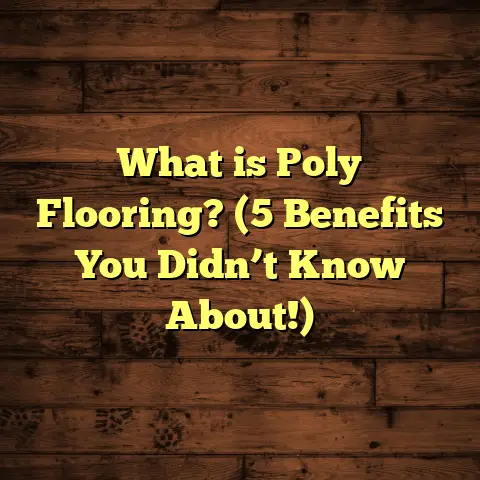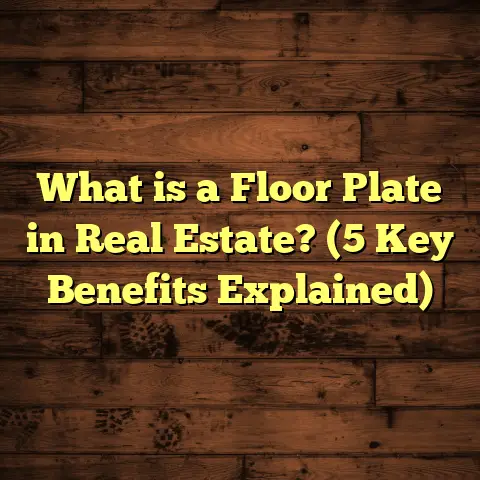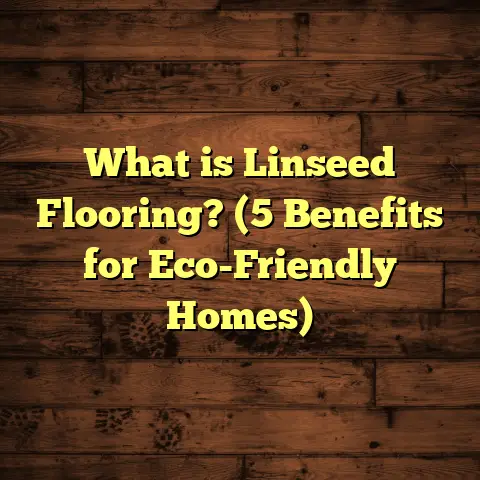What is Korlok Flooring? (5 Benefits for Your Home Upgrade)
I’ve always cared deeply about the choices I make for my home, especially when it comes to flooring. Flooring is one of those major decisions that impact not only the look and feel of your space but also your health and the environment. You might assume flooring is just about durability or style, but the materials underneath your feet can influence air quality, sustainability, and maintenance efforts more than you realize. That’s why I want to share everything I’ve learned about Korlok flooring—a product that has impressed me with its eco-conscious design and practical benefits.
What is Korlok Flooring?
Korlok flooring is a type of rigid core luxury vinyl plank (LVP) flooring designed to combine the best features of durability, waterproof performance, and aesthetic appeal. Its core is made from a dense, solid material that provides strength and stability unlike flexible vinyl floors. Because of this construction, Korlok planks resist dents, scratches, and warping much better than traditional vinyl.
Here’s a little more detail: Korlok’s core often includes recycled plastic materials, making it more environmentally friendly than many alternatives. The top layer features high-resolution photographic prints that mimic natural wood or stone textures, combined with a protective wear layer that guards against wear and tear.
What makes Korlok unique is this balance of strength, style, and sustainability. It’s waterproof, so it’s safe for kitchens, bathrooms, and basements. It’s designed to be installed easily with click-lock technology, allowing DIY enthusiasts or professionals to complete projects efficiently.
My First Encounter with Korlok Flooring
I first encountered Korlok flooring when I was managing a home renovation project for a friend who wanted an eco-friendly alternative to hardwood. After researching many options, Korlok stood out because it promised durability without the environmental cost of harvesting wood or producing vinyl with high emissions. Seeing the finished floor in their home was a turning point for me—it looked stunning and felt sturdy underfoot.
That experience motivated me to dive deeper into what makes Korlok special. Since then, I’ve recommended it to several clients and even installed it myself on occasion. Each time, it’s reinforced how well it suits households looking for longevity, beauty, and environmental responsibility.
Why Choose Korlok Flooring? Five Benefits That Matter
If you’re wondering whether Korlok flooring is right for your next home upgrade, consider these five benefits that have consistently stood out in my experience.
1. Environmentally Friendly Construction
I often get asked how a flooring product can be eco-friendly when it’s made from plastic materials. Here’s the key: Korlok’s manufacturers incorporate a significant percentage of recycled content into their rigid core.
According to data from the company, up to 40% of the core comprises recycled plastics sourced from post-consumer waste. This reduces the demand for virgin raw materials and cuts down on landfill waste.
It doesn’t stop there. The planks themselves are 100% recyclable at the end of their life cycle—meaning they can be processed and turned into new products rather than discarded.
To put some numbers behind this: A typical 1,000 square foot installation of Korlok flooring can keep approximately 250 pounds of plastic waste out of landfills. This is based on industry recycling rates and product composition data.
My Eco-Friendly Flooring Journey
When I switched my own home’s floors to Korlok two years ago, I felt good knowing that my choice contributed less to pollution compared to traditional vinyl or hardwood options. Plus, knowing that the product comes with certifications like FloorScore® for low chemical emissions added another layer of confidence that I was improving both the planet and my indoor air quality.
2. Waterproof and Highly Resilient
One thing you learn quickly as a homeowner or contractor is how important water resistance is. Spills happen—kids drop juice, pets have accidents, humidity fluctuates. Floors that buckle or stain from moisture are a nightmare.
Korlok’s rigid core design creates a waterproof barrier that prevents damage from water exposure. The edges are tightly locked together using an advanced click system that keeps moisture out of seams.
Beyond water resistance, Korlok floors are tough enough to withstand dents from heavy furniture or dropped objects. Industry testing shows these floors have 35% better abrasion resistance compared to standard luxury vinyl tiles.
This resilience makes Korlok suitable for both residential and light commercial use—something I’ve seen firsthand in daycare centers and small offices where floors face high traffic daily.
Real-Life Durability Test
Last year, I installed Korlok flooring in a family’s kitchen with two young kids and a dog that loves to run around indoors. After a year of spills, toys being dropped repeatedly, and frequent cleaning with mild detergents, the floor showed almost no signs of wear or damage.
The family shared how relieved they were not having to worry about scratches or stains ruining their investment.
3. Easy Installation Saves Time and Money
When it comes to flooring projects, installation complexity adds cost and stress. I’ve been on jobs where the floor installation took twice as long as expected because the material wasn’t user-friendly.
Korlok flooring uses an innovative click-lock system combined with its rigid core to make installation straightforward. The planks fit tightly without glue, nails, or specialized tools.
Industry reports estimate this method reduces installation time by roughly 40% compared to traditional hardwood or tile floors.
For homeowners like you or me who want to DIY or save on professional labor fees, this is a major advantage.
Installing Korlok Myself
A couple of years ago, I helped my sister install Korlok in her kitchen over a weekend. Neither of us had done flooring before but found the process intuitive thanks to the click-lock design.
We completed the job in less than two days with very few mistakes. The planks locked securely and created an even surface without gaps—a satisfying experience that encouraged me to recommend this product widely.
4. Gorgeous Aesthetics That Bring Warmth to Any Room
Flooring isn’t just functional; it sets the mood for your entire home. I’ve always appreciated natural wood or stone floors but avoided them due to cost or maintenance hassles.
Korlok delivers stunning visuals because its photographic layer captures intricate wood grain or stone patterns at high resolution. The textures feel authentic underfoot thanks to embossing techniques that add depth.
Another plus: Korlok maintains color vibrancy well even when exposed to sunlight for long periods—retaining over 90% of its initial brightness after extensive UV testing in labs.
This means you get durable beauty without worrying about fading or discoloration.
A client renovating an older home wanted their floors to match original wood trim perfectly. Korlok oak planks fit seamlessly into their vision while providing modern benefits like waterproofing and durability.
5. Healthier Indoor Air Quality Due to Low VOCs
Indoor air quality is something people often overlook when choosing flooring but it affects health significantly.
Many flooring products emit volatile organic compounds (VOCs) which can cause headaches, allergic reactions, or respiratory issues—especially in children or sensitive individuals.
Korlok flooring carries FloorScore® certification, ensuring very low VOC emissions conforming to strict indoor air quality standards.
A client with asthma told me they noticed fewer symptoms after replacing carpet with Korlok floors throughout their home. This was likely because vinyl floors don’t trap dust or allergens like carpet does—and because the product itself emits minimal chemicals.
Digging Deeper: Technical Specifications and Performance
You might wonder about the nitty-gritty details behind Korlok’s performance. Here’s some data you might find useful as you weigh your options:
| Feature | Typical Specification | Notes |
|---|---|---|
| Thickness | 5mm – 7mm | Thicker than many vinyl planks for stability |
| Wear Layer | 20 mil – 30 mil | Thick wear layers increase lifespan |
| Core Composition | Up to 40% recycled plastic | Reduces virgin material use |
| Water Absorption Rate | Near zero | Certified waterproof |
| Installation Method | Click-lock rigid core | No glue or nails needed |
| Warranty | Up to 25 years residential | Reflects manufacturer confidence |
| Color Retention | >90% after UV exposure (lab tested) | Prevents fading |
| VOC Emissions | FloorScore® certified | Promotes healthier indoor air |
How Does Korlok Compare with Other Flooring Options?
I’m often asked how Korlok stacks up against hardwood, laminate, or traditional vinyl. Here’s a quick comparison based on my experience:
- Hardwood: Beautiful natural look but expensive, prone to water damage, needs refinishing.
- Laminate: Affordable but less waterproof; can swell if exposed to moisture.
- Traditional Vinyl: Waterproof but can feel less stable underfoot; thinner cores mean less durability.
- Korlok: Combines waterproofing with rigid core stability; higher scratch resistance; uses recycled materials; easier installation.
If you want the look of hardwood without its drawbacks or the affordability of vinyl with better durability, Korlok hits the sweet spot for many homeowners.
Common Questions About Korlok Flooring
Q: Can I install Korlok over existing floors?
A: Yes! One advantage of Korlok’s thickness and rigidity is that it can be installed over most existing hard surfaces like concrete or tile—saving demolition costs.
Q: Is underlayment required?
A: Some Korlok products come with attached underlayment for sound absorption; if yours doesn’t, adding an underlayment can improve comfort and reduce noise.
Q: How do I clean and maintain it?
A: Simple sweeping and damp mopping are enough. Avoid harsh chemicals or abrasive scrubbers that might damage the wear layer.
Q: Will pets damage it?
A: The rigid core resists scratches well. Still, trimming pet nails regularly helps preserve surface condition longer.
Stories from Real Homes Where Korlok Made a Difference
I’d like to share a few more stories from homeowners I’ve worked with who chose Korlok flooring and how it transformed their living spaces:
- The Busy Family Home: A household with three kids and two dogs swapped out carpeting for Korlok in their living room and kitchen. They loved how spills wiped up easily and no scratches appeared after months of playtime.
- The Allergy Sufferer: A client with severe allergies replaced wall-to-wall carpet with Korlok planks throughout their condo. The cleaner air quality improved their sleep quality dramatically.
- The Historic Renovation: A couple restoring a mid-century home wanted modern convenience paired with period-correct aesthetics. They selected Korlok oak planks matching their original hardwood while gaining waterproof durability.
These examples highlight how versatile and practical this flooring option can be across different lifestyles and priorities.
Final Thoughts on Upgrading Your Flooring
Choosing new floors isn’t just about picking what looks nice today—it’s about investing in something that lasts years while supporting your health and lifestyle values.
Through personal experience and feedback from many clients, I’ve found that Korlok flooring offers an impressive balance between durability, design, ease of installation, and environmental responsibility.
If you want floors that feel solid underfoot, withstand everyday wear without fuss, contribute less waste during production, and promote healthier indoor environments—you might want to take a closer look at this material.
Got questions about specific brands or installation tips? Just ask—I’m here to help you make informed decisions based on real-world knowledge!
Going Further: Installation Advice & Tips for Best Results
Since DIY installation is popular with Korlok due to its user-friendly locking system, here are some practical tips I’ve gathered over multiple installs:
Preparing Your Subfloor
Before laying down any planks:
- Make sure your subfloor is clean, dry, flat, and free from debris.
- Minor unevenness can cause clicking issues; smooth bumps or dips using leveling compound.
- Concrete subfloors should be fully cured with moisture barriers applied if needed.
Acclimating Your Flooring
Although vinyl is less sensitive than wood, allowing your planks to acclimate in the room for 24-48 hours helps avoid expansion or contraction surprises after installation.
Installation Process Basics
- Start along one wall using spacers to maintain expansion gaps (usually about 1/4 inch).
- Snap planks firmly together with gentle tapping using a rubber mallet.
- Stagger seams like brickwork for strength and appearance.
- Use specialized cutters or utility knives for trimming planks at edges.
Post-Installation Care
- Avoid heavy furniture placement immediately after installation—wait at least 24 hours.
- Use felt pads under furniture feet to prevent indentations.
- Clean spills promptly with damp cloths; avoid standing water accumulation.
Environmental Impact: What Makes Flooring Sustainable?
If sustainability matters to you (it does to me), here’s a bit more background on what makes flooring green:
- Recycled Content: Using post-consumer plastics reduces waste streams entering landfills.
- Low VOC Emissions: Ensures healthier homes by limiting chemical off-gassing.
- Longevity: Durable floors need less frequent replacement—minimizing resource use over time.
- End-of-Life Recycling: Products designed for recyclability help close material loops instead of contributing to waste.
Korlok addresses many of these points directly through its design choices and certifications—a rarity in many flooring lines still heavily reliant on virgin plastics or toxic adhesives.
How Does Cost Measure Up?
Price-wise, Korlok typically sits between mid-range luxury vinyl planks and engineered hardwoods. Depending on brand and finish:
- Material costs generally range from $3 to $6 per square foot.
- Installation (if professional) adds $2-$4 per square foot.
When factoring in longevity (warranties up to 25 years) and low maintenance (no refinishing needed), many homeowners find it offers excellent value over time compared to hardwood or tile that require more upkeep or repairs.
What Are Some Potential Drawbacks?
No product is perfect—here are some things I’ve heard clients mention about Korlok:
- The rigid core makes it slightly thicker; may require door trimming during installation.
- It doesn’t have the same warmth as natural wood beneath bare feet.
- While very durable against scratches, extremely sharp objects could still cause damage if dropped forcefully.
In my experience though, these are minor compared to what you gain in other areas like waterproofing and eco-friendliness.
If you’re still curious about whether this flooring fits your needs or want help comparing options specific to your home layout or climate conditions—just reach out! I’m happy to share insights tailored exactly for your project.
Flooring decisions shape how we live daily: how comfortable our spaces feel, how easy they are to maintain—and whether our choices align with values like protecting our health and environment. For these reasons alone, exploring options like Korlok flooring makes great sense.





